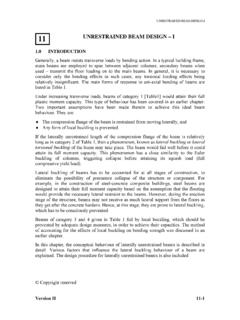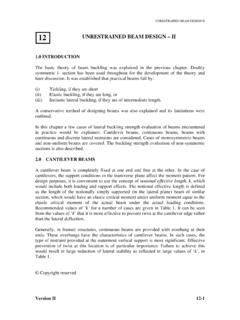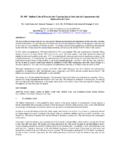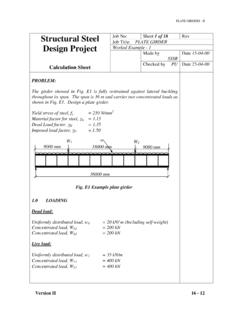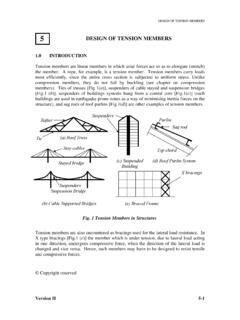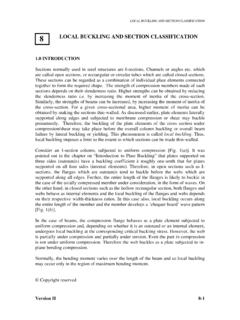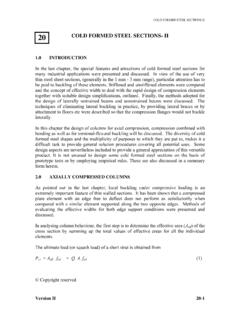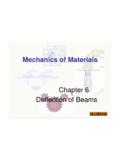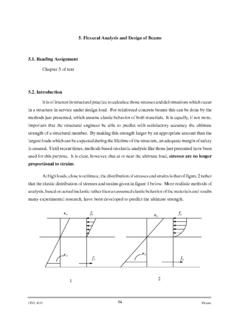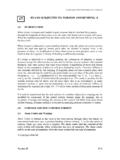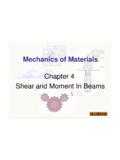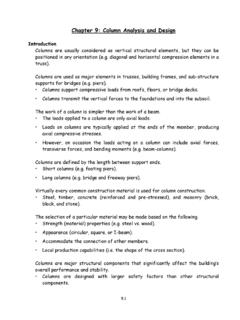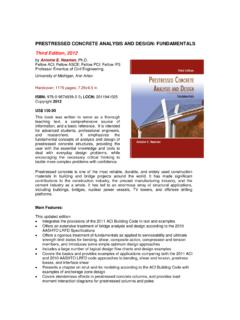Transcription of BEAMS SUBJECTED TO TORSION AND BENDING - II
1 BEAMS SUBJECTED TO TORSION & BENDING -II BEAMS SUBJECTED TO TORSION AND BENDING - II 18 INTRODUCTION In the previous chapter , the basic theory governing the behaviour of BEAMS SUBJECTED to TORSION was discussed. A member SUBJECTED to torsional moments would twist about a longitudinal axis through the shear centre of the cross section. It was also pointed out that when the resultant of applied forces passed through the longitudinal shear centre axis no TORSION would occur. In general, torsional moments would cause twisting and warping of the cross sections. When the torsional rigidity (GJ) is very large compared with its warping rigidity (E ), the section would effectively be in uniform TORSION and warping moment would unlikely to be significant from the designer's perspective.
2 Examples of this behaviour are closed hot-rolled sections ( rectangular or square hollow sections) and rolled angles and Tees. Note that warping moment is developed only if warping deformation is restrained. Warping deformation in angle and T-sections are not small, only warping moment would be small. On the other hand, most thin walled open sections have much smaller torsional rigidity (GJ) compared with warping rigidity (E ) values and these sections will be exhibiting significant warping moment. Hot rolled I sections and H sections would exhibit torsional behaviour in-between these two extremes and the applied loading is resisted by a combination of uniform TORSION and warping TORSION .
3 DESIGNING FOR TORSION IN PRACTICE Any structural arrangement in which the loads are transferred to an I beam by TORSION is not an efficient one for resisting loads. The message for the designers is "Avoid TORSION - if you can ". In a very large number of practical designs, the loads are usually applied in a such a manner that their resultant passes through the centroid. If the section is doubly symmetric (such as I or H sections) this automatically eliminates TORSION , as the shear centre and centroid of the symmetric cross section coincide. Even otherwise load transfer through connections may - in many cases - be regarded as ensuring that the loads are effectively applied through the shear centre, thus eliminating the need for designing for TORSION .
4 Furthermore, in situations where the floor slabs are supported on top flanges of channel sections, the loads may effectively be regarded as being applied through the shear centre since the flexural stiffness of the attached slab prevents TORSION of the channel. Where significant eccentricity of loading (which would cause TORSION ) is unavoidable, alternative methods of resisting TORSION efficiently should be investigated. These include Copyright reserved Version II 18 -1 BEAMS SUBJECTED TO TORSION & BENDING -II design using box sections, tubular (hollow) sections or lattice box girders which are fully triangulated on all faces. All these are more efficient means of resisting torsional moments compared with I or H sections.
5 Unless it is essential to utilise the torsional resistance of an I section, it is not necessary to take account of it. The likely torsional effects due to a particular structural arrangement chosen should be considered in the early stages of design, rather than left to the final stages, when perhaps an inappropriate member has already been chosen. PURE TORSION AND WARPING In the previous chapter , the concepts of uniform TORSION and warping TORSION were explained and the relevant equations derived. When a torque is applied only at the ends of a member such that the ends are free to warp, then the member would develop only pure TORSION .
6 The total angle of twist ( ) over a length of z is given by )1(JGzTq = where Tq = applied torque GJ = Torsional Rigidity When a member is in non-uniform TORSION , the rate of change of angle of twist will vary along the length of the member. The warping shear stress ( w) at a point is given by )2(tSEwmsw =where E = Modulus of elasticity Swms = Warping statical moment at a particular point S chosen. The warping normal stress ( w) due to BENDING moment in-plane of flanges (bi-moment) is given by w = - E .Wnwfs . '' where Wnwfs = Normalised warping function at the chosen point S. COMBINED BENDING AND TORSION There will be some interaction between the torsional and flexural effects, when a load produces both BENDING and TORSION .
7 The angle of twist caused by TORSION would be amplified by BENDING moment, inducing additional warping moments and torsional shears. The following analysis was proposed by Nethercot, Salter and Malik in reference (2). Version II 18 -2 BEAMS SUBJECTED TO TORSION & BENDING -II Maximum Stress Check or "Capacity check" The maximum stress at the most highly stressed cross section is limited to the design strength (fy / m). Assuming elastic behaviour and assuming that the loads produce BENDING about the major axis in addition to TORSION , the longitudinal direct stresses will be due to three causes. )3(..'' === nwfswyytbytxxbxWEZMZM byt is dependent on Myt, which itself is dependent on the major axis moment Mx and the twist.
8 Myt = Mx (4) Thus the "capacity check" for major axis BENDING becomes: bx + byt + w fy / m. (5) Methods of evaluating , , and for various conditions of loading and boundary conditions are given in reference (2). Buckling Check Whenever lateral torsional buckling governs the design ( when pb is less than fy) the values of w and byt will be amplified. Nethercot, Salter and Malik have suggested a simple "buckling check" along lines similar to BS 5950, part 1 ()())6( +++ where , equivalent uniform moment = mx Mx xM ()212pEBBpEMMMM + and Mb , the buckling resistance moment = Version II 18 -3 BEAMS SUBJECTED TO TORSION & BENDING -II in which ()2M1 MELTpB++= MP , the plastic moment capacity = fy.
9 Zp / m Zp = the plastic section modulus ME , the elastic critical moment = where LT is the equivalent slenderness. my2LT2pfEM Applied loading having both Major axis and Minor axis moments When the applied loading produces both major axis and minor axis moments, the "capacity checks" and the "buckling checks" are modified as follows: Capacity check: bx + byt + w + by fy/ m (7) Buckling check: ()() )8(1//== ++++ Torsional Shear Stress Torsional shear stresses and warping shear stresses should also be amplified in a similar manner: ())9( ++= This shear stress should be added to the shear stresses due to BENDING in checking the adequacy of the section.
10 DESIGN METHOD FOR LATERAL TORSIONAL BUCKLING The analysis for the lateral torsional buckling is very complex because of the different types of structural actions involved. Also the basic theory of elastic lateral stability cannot be directly used for the design purpose because Version II 18 -4 BEAMS SUBJECTED TO TORSION & BENDING -II the formulae for elastic critical moment ME are too complex for routine use and there are limitations to their extension in the ultimate range A simple method of computing the buckling resistance of BEAMS is given below. In a manner analogous to the Perry-Robertson Method for columns, the buckling resistance moment, Mb, is obtained as the smaller root of the equation (ME - Mb) (Mp - Mb) = LT.

